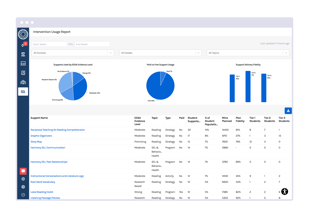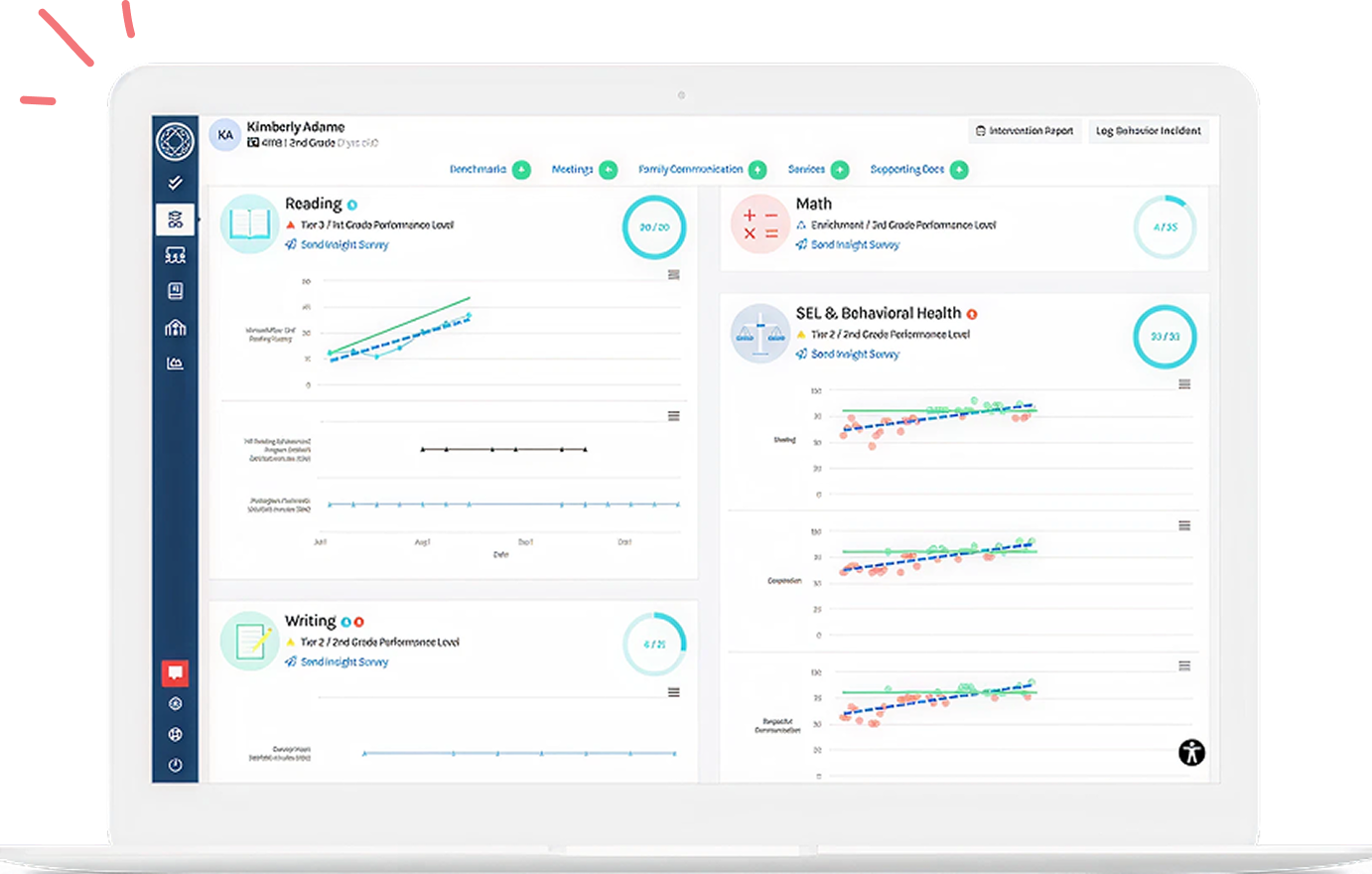As the halfway point in the Elementary and Secondary School Emergency Relief (ESSER) Fund time frame approaches and the remaining deadlines to leverage funds come into focus, district administrators should be asking two questions:
- How can I best leverage these federal dollars to support student success?
- Have the tools and programs we’ve purchased so far been used?
Wait a minute; you may be thinking. “Have the tools and programs we’ve purchased so far been used?!” We needed these supports! Shouldn’t wide adoption be a foregone conclusion? Well, if your district is in line with the average, studies show that:
- The category for ESSER fund spending you’ve invested the most in so far is learning loss. According to Burbio’s School Budget Tracker, the Learning Loss category has commanded 30% of overall fund expenditure, the highest among other categories. Learning Loss Recovery expenditures include Math/ELA Coaching and Programming, Instructional Software/Licenses, Student Assessments, and Instructional Software—all important components of a strong Multi-Tiered System of Supports (MTSS).
AND - Much of the software you’ve purchased has gone unused. According to a 2019 EdWeek Market Brief, K-12 districts waste millions of dollars every year by purchasing instructional programs and materials that never get fully adopted by teachers. In the report, a study showed that of $2 billion in school spending researched, 67% of the educational software purchased was unused or underused.
Yikes.
Enhancing Teacher Adoption of Digital Tools and Systems in MTSS Implementation
In a well-implemented MTSS, teachers know how and when to use an intervention or resource effectively for Tier 2 or Tier 3 levels of support. But this may not be happening consistently. In a survey cited by a 2019 Edweek Report, researchers found that teachers were not implementing digital tools and systems as prescribed.
Reasons for poor adoption included:
- Lack of awareness regarding how the tools were relevant to students' needs, as well as the knowledge and skills they could help develop.
- Inadequate communication from the administration regarding adoption expectations.
Strategies for Effective MTSS Resource Utilization
1. Embed MTSS protocols and procedures
One way to ensure teachers know how and when to use interventions and supports is to embed MTSS protocols and procedures with guidance around what resources are available, as well as best practice recommendations for the appropriateness of those programs as they relate to a student’s grade level performance, level of English proficiency, tier recommendation, and challenge area.
2. Map out district expectations
Mapping out district expectations for the approaches to be used with students who are demonstrating challenges in specific skills and with particular materials, as well as recommendations regarding dosage and frequency of interventions, gives teachers a map to leveraging the tools effectively. With all of the pressures and distractions teachers face on a daily basis, scaffolding their intervention work with best-practice guidance around the use of resources will help them—and their students—succeed. It also ensures the platforms the district has invested in are used well.
|
At Branching Minds, we believe that MTSS software is only as good as the MTSS practice it supports. We take a partnership approach to help schools and districts achieve an effective, efficient, and equitable MTSS practice. We believe sustainable growth happens when districts are supported not just by their technology adoptions, but by their system-level practices, protocols, and resources. The BRM Professional Services Team is able to provide professional development and coaching that is custom-designed to your needs. |
3. Administrators need to routinely monitor intervention fidelity & overcome the challenges of fragmented data
Administrators, both at the school and district level, should also routinely monitor the fidelity of intervention delivery and the supports being leveraged to support student needs. Overcoming the challenge of fragmented data is necessary in order to comprehensively review the interventions being implemented in the MTSS, and so consolidating documentation of support plans for all tiers and grade levels and across all subjects (academic, behavioral, attendance, and SEL) creates an opportunity for administrators to see how the system is being implemented from a bird’s eye view.
In a 2022 Op-Ed published in The Hill, Marguerite Roza and Chad Aldeman of Edunomics Lab put the magnifying glass to what they called “[a] dearth of data in education [that] is reaching four-alarm status.” Roza and Alderman challenged public school administrators to capture and critically review data illustrating how interventions are being used, and whether they’re working. “Making decisions without data means that we invest in programs but don’t change course if they’re not working,” they said. “It means we have no idea if the fleet of newly hired counselors has any effect on mental health. It means instead of targeting remedial fractions to students who need it, we either re-teach fractions to everyone or to no one.”
View and Report Intervention Usage
 As district and school administrators look to implement MTSS with fidelity, they need easy ways to understand if the interventions their teachers are using are one’s with an appropriate level of evidence and if they are being delivered in accordance with the support plan design. Branching Minds’ Intervention Usage Report allows school and district manager users to view and report on intervention usage across their network, schools, grades, staff, and topics. The graphs display the breakdown of those interventions by ESSA evidence levels, paid vs. free, and support delivery fidelity by tier. Within each row, administrators can understand the aggregate usage of each intervention. All of this data can be sorted and exported.
As district and school administrators look to implement MTSS with fidelity, they need easy ways to understand if the interventions their teachers are using are one’s with an appropriate level of evidence and if they are being delivered in accordance with the support plan design. Branching Minds’ Intervention Usage Report allows school and district manager users to view and report on intervention usage across their network, schools, grades, staff, and topics. The graphs display the breakdown of those interventions by ESSA evidence levels, paid vs. free, and support delivery fidelity by tier. Within each row, administrators can understand the aggregate usage of each intervention. All of this data can be sorted and exported.
In Conclusion
Given the profound impact of the pandemic on student outcomes and student wellness, it’s no surprise that so much of ESSER funding has gone to purchase programs and tools that help teachers intervene with students who need additional support. Student need is great, and when a differentiated and appropriate core curriculum fails to meet so many students where they are, it’s a natural act to invest in intervention resources. But no intervention is a magic bullet; no platform is a magic bullet. Student outcomes don't improve at the point of purchase. It's the fidelity of practice, and the solidity of implementation, with the right training and the right infrastructure, that make the difference.
Looking ahead to the September 30th, 2023, ESSER II allocation deadline, a challenge each public school administrator can rise to is one of leadership and accountability. With each product purchased, have a scaffolded plan to guide adoption that will set teachers up for success and save them mental space. And proactively implement those intervention resources within a larger framework of MTSS that consolidates reporting so you can review usage and ensure they’re being implemented with fidelity.
👉 Request a demo of the Branching Minds platform and implementation support options.
Key Takeaways:
- ESSER funds are being used to purchase tools to reverse learning loss, but many of the products purchased are underutilized or unused altogether.
- Teachers need explicit guidance on which intervention programs to use, with which students, when, and how in order for a Multi-Tiered System of Supports to be successful
- Administrators can ensure products are being adopted to support student success as envisioned with a consolidated system for intervention tracking and delivery across all subject areas and grade levels.
|
|
|
|
Enable Your Educators and Administrators to:
|
|
Citations:
https://about.burbio.com/school-budget-tracker
https://www.edweek.org/technology/districts-often-out-of-touch-with-teachers-biggest-tech-needs-survey-finds/2019/04https://thehill.com/opinion/education/3666023-public-education-missed-the-data-revolution-its-time-to-catch-up/

About the author
Emily-Rose Barry
Ms. Barry is the VP of Product at Branching Minds. She has worked in Education Technology in roles overseeing Product and Customer Success for the past ten years. Before joining the world of agile software development, she taught reading and writing at every level from early childhood to college, administered special programs for an adult literacy nonprofit, and published short fiction and poetry as a freelance writer. She is a co-founder of ProductTank Buffalo, a local community for networking and professional development.

Your MTSS Transformation Starts Here
Enhance your MTSS process. Book a Branching Minds demo today.













.png?width=1436&height=956&name=Purchase%20%E2%89%A0%20Progress%20Leveraging%20ESSER%20Funds%20for%20MTSS%20Implementation%20(1).png)


.png?width=716&height=522&name=Addressing%20Foundational%20Reading%20Skills%20in%20MTSS%20(preview).png)
.png?width=716&height=522&name=Understanding%20Literacy%20Basics%20(Preview).png)
